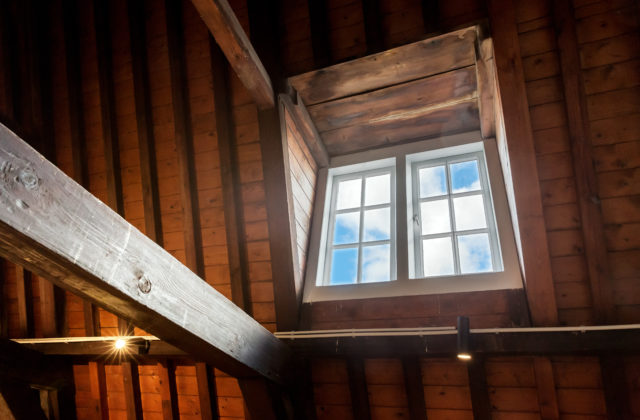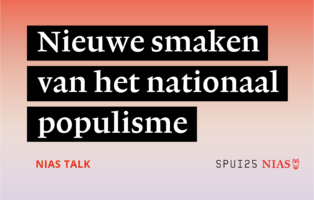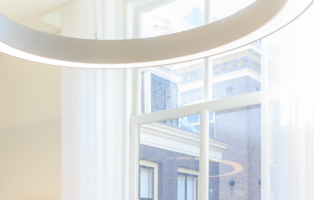White men in South Africa were strictly prohibited from having sex with black women during the Apartheid era. The other way around as well, of course, but white men were by no means spared. Punishments were severe and many committed suicide while awaiting trial as the shame was just too powerful. But how could it be that once the Apartheid regime learned about the suicide trend, it plainly did not care?
It is the question that Canadian historian Susanne Klausen raises in her presentation. It is Thursday, March 12, in the atticOnce the Apartheid regime learned about the suicide trend, it plainly did not care. How could that be?of the Netherlands Institute of Advanced Study (NIAS). Together with about thirty fellow fellows, I searched with her for a possible answer to the questions she posed. With the dark beams, the soft light and the sand coloured sofa, the space has a homely feel. From the window you look at the monumental canal houses on the Oudezijdsachterburgwal. I liked to work there and saw myself putting my own book together. But on that particular Thursday, that dream is shattered.
NIAS will close until further notice
Earlier that week it had become clear that the corona virus had also spread in the Netherlands. It seemed a matter of days before the government announced far-reaching measures. The Royal Netherlands Academy of Arts and Sciences (KNAW), of which NIAS is a part, did not want to await those measures and Klausen’s presentation was hardly over when staff members came in and handed out A4s. Most important message: NIAS will close until further notice. The fellows were able to get things from their office the next day; on Monday there might still be a shared lunch. The building would close from Tuesday. The management was hopeful that it would open again after a few weeks.
Things turned out differently, because the building would not open again until June, and then very slowly, bit by bit. The shared lunches were out of the question; research presentations were all online. One worked from home. Of course, this was not how I had imagined it when I applied for a place as a journalist-in-residence at NIAS in December. Someone had dropped out, and the Fonds Bijzondere Journalistieke Projecten (FBJP) had set up a quick procedure to ensure that another journalist would be able to work at NIAS on 3 February.
National Populism in Europe
For a year and a half, I had been working on a series about the rise and impact of European national populism, which had taken me criss-cross across the continent. Gradually the idea was born to turn my observations into a book and NIAS seemed the best place to do such a thing. My own workplace, a monthly allowance, an inspiring group of colleagues with whom I could discuss the subject to my heart’s content – all factors that are not self-evident for a freelancer, at least not for me. An additional advantage was that I would stay in the Netherlands for a longer period of time, and after more than 15 years abroad, I was also looking forward to that. The quick procedure turned out to be as fast as promised, because soon after sending in my application, I received a message: the board was enthusiastic about my project and I could take up the position.
Concretely, that meant that I had to set a planned trip to Hungary in motion. I had been to England and Austria, I went across France and Italy. The project could not do without a visit to Hungary. I already had the angle, thanks to L’Incorrect, a weekly newspaper close to the nationalist conservative Marion Maréchal, the dream presidential candidate of the radical right in France.
A while ago L’Incorrect had a special about Hungary and Poland entitled: Le soleil se lève à l’Est (The sun rises in the East). In the West we tend to see countries such as Hungary and Poland in a negative light. But radical right parties and movements don’t care about allegations of curtailing the free press or undermining the rule of law. They see these countries, and especially Orbán’s Hungary, as an inspiring example and shining beacon. But what do they actually see? I wanted to understand that by talking to figures in or close to Hungarian power – ministers, ideologues, academics and pro-government journalists.
I spent just under three weeks in an icy Hungary in January, and with over 30 hours of interviews, I boarded the Thalys from my hometown Paris on February 2 to Amsterdam where my NIAS fellowship would begin a day later. Just past Antwerp I discovered that my two suitcases had disappeared from the train’s luggage deck. Stolen. My clothes, shoes, my books, my notes, my passport, my driver’s license, the bottle of Chassangne-Montrachet that I brought for a friend – everything gone. I only had my laptop and my charger left. Coincidentally I had just taken it out of my suitcase before Brussels to do some work.
(Not) a good start
That was not a good start, and the weeks of rainfall, the storm and the darkness that awaited me in Amsterdam did not help either. What did help was the beautiful apartment that was allotted to me at the NIAS Fellows House on the Kloveniersburgwal. Hidden behind the actual canal house, with its own entrance in a side-alley, and a view of the Zuidertoren. What also helped was the welcome – I could not have wished for a warmer welcome. My fellow fellows, for the most part lecturer-researchers at university, were also pleasantly surprised. In the teaching factories that modern universities have become, they had gotten used to being at the bottom of the hierarchy. But at NIAS, the staff was at the service of the researchers and not of themselves or the managers. A relief.
We all had our own study, there was a lunchroom where we were expected to eat together at least four days a week. There were also weekly presentations, and in between those, excursions, drinks, or just a chat with a neighbouring colleague. In retrospect, this was a blessing, because it meant that in those five weeks that it took before NIAS closed due to corona, we had the chance to at least get to know each other. And that was useful when the presentations continued as video conferences.
The lockdown meant I was thrown back to the fellows’ house and its residents. Some had chosen to return home, while others stayed. Some simply did not want to get out of the flow of their writing; others could not return, for example because their country’s airports were closed (South Africa and Cameroon). Another fellow, a refugee academic from Kurdish-Iran could not return anyway, but his wife was trapped in Tehran and experienced anxious weeks. During the first few weeks in particular, we met daily to keep each other up to date about the situation. I often came to act as the liaison between Dutch society and politics and the international fellows, because there were of course numerous questions about the – sometimes incomprehensible – government policies (moving towards group immunity yes or no). At the same time, the world outside entered my life with all kinds of poignant stories about friends and family far away.
Unforeseen possibilities
Working on the book seemed out of the question, during those first two months. How could one work if one’s world fell apart, or at least had every appearance of doing so? On top of that, for me it was completely unclear what the world would look like after “corona” and what that would mean for “my” national populists. My reports could be thrown in the trash, so it seemed to me. What else would it explain than yesterday’s world?
At the same time, the semi-lockdown also offered unforeseen possibilities, such as long walks through an old, forgotten Amsterdam. Sometimes I went out several times a day. The weather was always beautiful, the sky inimitably blue, and on the Nieuwmarkt square there was always some life, if only an outlet where you could pick up a freshly made cappuccino. At the Fellows House, the salon and the kitchen with the enormous cooking island also offered possibilities. I organised many dinners there, for my fellow fellows, but also for friends from outside. Fishmonger Tel, right next to the fellows’ house and open during the lockdown, delivered the fish, from plaice, hake and sea bass to halibut and sea bream – I can’t remember a period in my life when I ate fish so frequently as during my stay at the fellows’ house.
After several weeks the presentations resumed, but, to be honest, it couldn’t really inspire me. I don’t think anyone, but it was a way to keep busy, still maintain a certain contact with each other. I used my time to read, often in books that otherwise I would not have opened so quickly, such as the oeuvre of historian Henk Wesseling (also former director of NIAS). Or the beautiful book about the Avant-Garde by Sjeng Scheijen. In the meantime I worked steadily on my piece about Hungary; let me at least finish that, I thought. And I came to realise that being in Amsterdam was not too bad after all. Certainly not in comparison with Paris where a real lockdown was taking place.
Careful new plans
But how would life continue after the pandemic? Could I still travel? Not an unimportant question as a traveling journalist. And how should the book proceed? As far as the latter was concerned, Mai Spijkers, my publisher, came to the rescue. During a dinner party at the fellows’ house (I brought the fish; he brought the wine), he offered a new, topical angle. Not entirely selfless, because “a book has to sell of course”. When after a month or two the pandemic in the Netherlands was somewhat under control again, careful plans could be made again. Also at NIAS. The building reopened in June, albeit with all kinds of restrictions. There were now red and green arrows everywhere that indicate the walking direction and made it clear where you could sit or not. There were no longer any communal lunches, nor seminars. I did, however, initiate a panel discussion on national populism at Spui25 with my fellow fellow Matthijs Lok. NRC journalist Marc Lievisse Adriaanse and UvA political scientist Sarah de Lange also sat down. It was allowed to take place on location. Without an audience, but this was at least something.
SUP board in a marble corridor
From then onwards I worked partly at home, partly in the pleasant attic of NIAS. At every possible occasion, I got on my SUP board, bought especially to explore the waterways of Amsterdam during corona-times. I enjoyed the surprised looks of tourists when I, on my return, dragged the SUP board into the marble corridor of the monumental canal house.
No, I don’t think I could have wished for a nicer and more inspiring place than NIAS, and I am very grateful to the FBJP for giving me the opportunity to have stayed there for seven months. The only thing left to do is just finish writing that book.
This report was originally written in Dutch, and can be found on the website of the Fonds Bijzondere Journalistieke Projecten.




